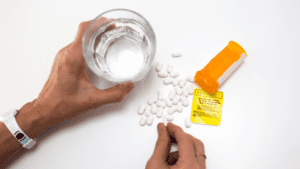When heavy, prolonged alcohol consumption is abruptly stopped, the body and mind may go into a state of shock, triggering severe and dangerous withdrawal symptoms. One of the most alarming and life-threatening conditions that can develop during this process is Alcohol Withdrawal Delirium, commonly referred to as delirium tremens (DTs). Recognizing the early warning signs and understanding the causes, symptoms, and treatment options can help prevent fatal outcomes for those affected by alcohol dependence.
In this comprehensive guide, we’ll explore the various aspects of Alcohol Withdrawal Delirium, including its causes, the groups at risk, symptoms, the typical timeline of alcohol withdrawal, the process of diagnosis, treatment methods, possible complications, long-term outlook, prevention, and available support options.

What is Alcohol Withdrawal Delirium?
Alcohol Withdrawal Delirium is the most severe form of alcohol withdrawal syndrome. It occurs when a person who has been drinking heavily for an extended period stops drinking suddenly or reduces their intake drastically. This condition is a medical emergency that requires prompt treatment because, without intervention, it can lead to life-threatening complications such as heart failure, seizures, and even death.
Delirium tremens typically manifests as a combination of severe confusion, hallucinations, and tremors. It is a result of the brain’s overactivity due to the lack of alcohol, which had previously been depressing central nervous system activity. When alcohol is abruptly removed, the brain’s neurotransmitters become over-excited, leading to a dangerous state of hyperactivity.
Causes of Alcohol Withdrawal Delirium
The primary cause of delirium tremens is the sudden cessation or significant reduction of alcohol intake in individuals who have developed physical dependence on alcohol. Over time, the body adapts to the presence of alcohol, and the brain compensates for the depressant effects of alcohol by producing more excitatory neurotransmitters such as norepinephrine. When alcohol is abruptly discontinued, the brain remains in an overly excited state, leading to withdrawal symptoms and, in some cases, delirium tremens.
Factors that contribute to the development of delirium tremens include:
- Heavy long-term alcohol use: Drinking large amounts of alcohol regularly over a period of months or years can lead to the body becoming dependent on alcohol to maintain normal function.
- Previous history of alcohol withdrawal: Individuals who have experienced withdrawal symptoms in the past are at an increased risk of developing more severe symptoms, including delirium tremens.
- Co-occurring illnesses: Those with infections, liver disease, or other medical conditions are more likely to experience severe withdrawal.
- Age and overall health: Older adults and those with weakened immune systems or poor overall health are more vulnerable to the effects of alcohol withdrawal.
It’s important to note that not everyone who stops drinking after heavy alcohol use will develop delirium tremens, but certain risk factors make some individuals more susceptible.
At-Risk Groups for Delirium Tremens
Certain populations are at a higher risk of experiencing delirium tremens during alcohol withdrawal. Understanding who is most vulnerable can help identify individuals who may need additional medical support during the detox process.
At-risk groups include:
- Chronic heavy drinkers: Individuals who consume large quantities of alcohol daily for months or years are more likely to experience severe withdrawal symptoms, including delirium tremens. The likelihood of DTs increases with the duration and intensity of alcohol use.
- People with a history of alcohol withdrawal: If someone has experienced symptoms such as tremors, sweating, or anxiety during previous withdrawal attempts, they are at higher risk of developing DTs in future withdrawal episodes.
- Older adults: As people age, their bodies become less efficient at metabolizing alcohol. Older adults who have been drinking heavily for years may experience more severe withdrawal symptoms, making them more prone to developing DTs.
- Individuals with co-existing medical conditions: Those with conditions such as heart disease, liver damage, or compromised immune systems may experience more intense and dangerous withdrawal symptoms.
- People with a history of mental health disorders: Anxiety, depression, or other mental health issues can exacerbate the psychological symptoms of alcohol withdrawal, increasing the likelihood of delirium tremens.
- Individuals with poor nutrition or vitamin deficiencies: Heavy drinking can lead to malnutrition, particularly deficiencies in important vitamins like thiamine (B1), which is critical for brain function. Thiamine deficiency is a key factor in the development of Wernicke-Korsakoff syndrome, which is often associated with alcohol withdrawal delirium.
Symptoms of Delirium Tremens
The symptoms of delirium tremens are severe and can escalate quickly. While some individuals may experience only mild withdrawal symptoms, others may develop life-threatening conditions. The symptoms of delirium tremens typically appear 2 to 3 days after the last drink but can emerge anywhere from 48 to 72 hours after cessation of alcohol use.
Common symptoms of delirium tremens include:
- Severe confusion and disorientation: The person may not know where they are, who they are, or what is happening around them. This confusion can cause them to act erratically or become agitated.
- Hallucinations: Visual, auditory, or tactile hallucinations are common. The individual may see things that aren’t there, hear voices, or feel sensations like bugs crawling on their skin. These hallucinations can be disturbing and lead to panic or violent behavior.
- Tremors (shaking): Severe trembling, especially in the hands, is a hallmark symptom of DTs. These tremors can make it difficult for the individual to perform basic tasks.
- Severe agitation and anxiety: People experiencing DTs may be highly agitated, restless, and unable to calm down. This can lead to violent outbursts or erratic behavior.
- Fever: Body temperature may rise significantly, sometimes accompanied by sweating and chills.
- Rapid heart rate and high blood pressure: The heart may race, and blood pressure may spike, increasing the risk of heart attack or stroke.
- Seizures: Alcohol withdrawal seizures are common and can occur before or during delirium tremens. Seizures are a medical emergency and require immediate treatment to prevent brain damage or death.
The intensity and duration of symptoms can vary depending on the individual’s overall health, the severity of alcohol dependence, and how quickly they receive medical attention. For some, delirium tremens can last for several days, with the risk of complications increasing over time.
Alcohol Withdrawal Timeline
The symptoms of alcohol withdrawal follow a general timeline, though individual experiences may vary based on factors such as the person’s history of alcohol use and overall health.
Here’s a general timeline of what to expect during alcohol withdrawal:
- 6-12 hours after the last drink: Mild withdrawal symptoms begin, such as headaches, nausea, anxiety, irritability, sweating, and difficulty sleeping. During this stage, the body is adjusting to the absence of alcohol, and cravings for alcohol may intensify.
- 12-24 hours after the last drink: Symptoms may become more severe. In addition to the initial symptoms, the person may experience hand tremors, increased heart rate, elevated blood pressure, and possible hallucinations.
- 24-48 hours after the last drink: The risk of seizures increases during this period. People may also experience increased confusion, restlessness, and disorientation. Hallucinations can become more intense.
- 48-72 hours after the last drink: This is the most critical period for individuals at risk of developing delirium tremens. The symptoms of DTs, including severe agitation, hallucinations, tremors, and seizures, are most likely to appear during this time. Medical intervention is essential to manage symptoms and prevent fatal outcomes.
- 72 hours and beyond: If delirium tremens sets in, it may last for 3 to 7 days, although some symptoms can persist for longer. After the acute phase, individuals will begin the process of recovery, but ongoing support and monitoring are necessary to prevent relapse.
Diagnosis of Delirium Tremens
Diagnosing alcohol withdrawal delirium requires a thorough assessment by a healthcare professional. Diagnosis is typically based on a combination of the patient’s medical history, alcohol consumption patterns, and the presentation of withdrawal symptoms.
Diagnostic steps may include:
- Physical examination: The doctor will check for signs of dehydration, tremors, rapid heartbeat, high blood pressure, and other physical symptoms of alcohol withdrawal.
- Medical history: A detailed history of the individual’s alcohol use, including the duration and amount of alcohol consumed, is important for assessing the risk of delirium tremens.
- Mental status evaluation: The doctor may assess the individual’s level of confusion, disorientation, and awareness of their surroundings. Hallucinations and agitation are also key indicators of delirium tremens.
- Laboratory tests: Blood tests may be ordered to check for electrolyte imbalances, dehydration, liver function, and other medical issues that may complicate withdrawal. Tests may also be conducted to rule out other conditions that could cause similar symptoms, such as infections or head injuries.
Treatment for Delirium Tremens
Delirium tremens is a medical emergency that requires immediate hospitalization. The primary goal of treatment is to stabilize the individual, manage withdrawal symptoms, and prevent complications such as seizures, heart failure, or respiratory arrest. Treatment is typically provided in an intensive care unit (ICU) or specialized detoxification facility.
Key components of treatment include:
- Benzodiazepines: These medications, such as diazepam (Valium) or lorazepam (Ativan), are the most commonly used to reduce the severity of withdrawal symptoms, including seizures and agitation. Benzodiazepines work by calming the nervous system and preventing over-excitation caused by alcohol withdrawal.
- Intravenous fluids: Dehydration is common in individuals with delirium tremens, and intravenous (IV) fluids help to maintain hydration and restore electrolyte balance. IV fluids can also deliver essential nutrients that may be lacking due to malnutrition.
- Thiamine (Vitamin B1): Thiamine deficiency is common in people with alcohol use disorder and can contribute to brain damage and cognitive impairment. Administering thiamine can help prevent Wernicke-Korsakoff syndrome, a severe neurological condition associated with alcohol withdrawal.
- Antipsychotic medications: In cases where hallucinations or severe agitation are present, antipsychotic drugs such as haloperidol may be prescribed to manage these symptoms.
- Monitoring vital signs: Continuous monitoring of the individual’s heart rate, blood pressure, and respiratory function is essential to detect and manage complications early.
- Nutritional support: Individuals who have been drinking heavily for long periods are often malnourished, and nutritional support is a critical component of the recovery process.
Complications of Delirium Tremens
Delirium tremens can result in several serious complications if not treated promptly. These complications can be life-threatening and require immediate medical attention.
Potential complications include:
- Seizures: One of the most dangerous complications of delirium tremens is the onset of seizures. Alcohol withdrawal seizures are a leading cause of death in individuals experiencing DTs.
- Cardiac complications: The rapid heart rate and elevated blood pressure associated with delirium tremens can lead to heart attack, arrhythmia, or stroke.
- Respiratory failure: Severe agitation and confusion may result in difficulty breathing, leading to respiratory failure if not managed quickly.
- Infections: Individuals experiencing delirium tremens may have weakened immune systems, making them more susceptible to infections, such as pneumonia or urinary tract infections.
- Cognitive impairment: In severe cases, delirium tremens can cause long-term cognitive impairment, especially if the individual develops Wernicke-Korsakoff syndrome, a form of alcohol-related brain damage.
Long-Term Outlook for Delirium Tremens
With prompt and appropriate medical intervention, most individuals recover from delirium tremens without long-term complications. However, the risk of death increases significantly if treatment is delayed or if the individual has underlying health conditions that complicate recovery.
The long-term outlook also depends on the individual’s ability to maintain sobriety after recovering from delirium tremens. Alcohol dependence is a chronic condition, and relapse is common if the individual does not receive ongoing support and treatment.
Preventing Delirium Tremens
The most effective way to prevent delirium tremens is to seek medical help before attempting to quit alcohol. A medically supervised detox program can help manage withdrawal symptoms and reduce the risk of developing DTs. This is especially important for individuals with a history of heavy drinking or previous withdrawal episodes.
Additional preventive measures include:
- Gradual reduction of alcohol consumption: Rather than stopping alcohol use suddenly, it may be safer to taper down gradually under medical supervision.
- Regular medical check-ups: Individuals who drink heavily should have regular check-ups to monitor their health and address any underlying conditions that may complicate alcohol withdrawal.
- Nutritional support: Ensuring that the individual receives proper nutrition, including adequate levels of thiamine and other essential vitamins, can help reduce the risk of complications during alcohol withdrawal.
Support for Individuals Recovering from Delirium Tremens
Recovery from alcohol dependence is a long-term process that requires ongoing support and treatment. There are several resources available for individuals recovering from delirium tremens, including:
- Alcohol rehabilitation programs: Inpatient or outpatient rehab programs provide structured treatment plans that include medical care, counseling, and therapy to help individuals maintain sobriety.
- Support groups: Alcoholics Anonymous (AA) and other 12-step programs offer peer support and guidance for individuals in recovery.
- Counseling and therapy: Cognitive-behavioral therapy (CBT) and other therapeutic approaches can help individuals address the underlying psychological issues that contribute to alcohol dependence.
- Medication-assisted treatment: In some cases, medications such as naltrexone, acamprosate, or disulfiram may be prescribed to reduce alcohol cravings and prevent relapse.
- Family support: Involving family members in the recovery process can provide the individual with a strong support system and increase their chances of long-term success.
For those struggling with alcohol addiction, finding the right support is crucial. Spokane offers several resources for those seeking help. Addiction Help Finder in Spokane is a valuable tool for locating local treatment centers and recovery programs that can provide both immediate assistance and long-term recovery solutions.
FAQs
1. What causes Delirium Tremens (Alcohol Withdrawal Delirium)?
Delirium Tremens is caused by a sudden cessation or significant reduction of alcohol intake in individuals who have been drinking heavily for a prolonged period. The abrupt absence of alcohol causes the brain to become overactive, leading to severe withdrawal symptoms.
2. Who is most at risk of developing Delirium Tremens?
Those at the highest risk include people with a long history of heavy alcohol consumption, individuals who have previously experienced alcohol withdrawal, those with underlying health conditions (e.g., liver disease), and older adults. Poor nutrition and vitamin deficiencies also increase the risk.
3. What are the symptoms of Delirium Tremens?
Common symptoms include severe confusion, hallucinations, tremors, rapid heart rate, high blood pressure, excessive sweating, and in severe cases, seizures. Symptoms typically appear within 48-72 hours after stopping alcohol.
4. How is Delirium Tremens treated?
Treatment includes hospitalization, benzodiazepines to manage agitation and seizures, IV fluids to prevent dehydration, thiamine supplements to prevent brain damage, and continuous monitoring of vital signs. Early intervention is critical for recovery.
5. How can Delirium Tremens be prevented?
The best prevention is seeking medical help before quitting alcohol. A medically supervised detox program can safely manage withdrawal symptoms. Gradual reduction of alcohol consumption, rather than abrupt cessation, can also help prevent DTs.
Conclusion
Delirium Tremens is a severe, life-threatening condition associated with alcohol withdrawal that demands immediate medical attention. Recognizing the causes, at-risk groups, symptoms, and treatment options can significantly improve outcomes for individuals experiencing alcohol withdrawal delirium. Early intervention, especially in a supervised medical setting, is essential for managing the condition and preventing dangerous complications.
Recovery from alcohol dependence is a long-term process that requires ongoing support and dedication. Preventing Delirium Tremens begins with seeking professional help before attempting to quit alcohol, ensuring a safe and controlled detoxification process. If you or a loved one is at risk, resources like the Addiction Help Finder in Spokane can provide local assistance and guide you through the journey toward recovery.










